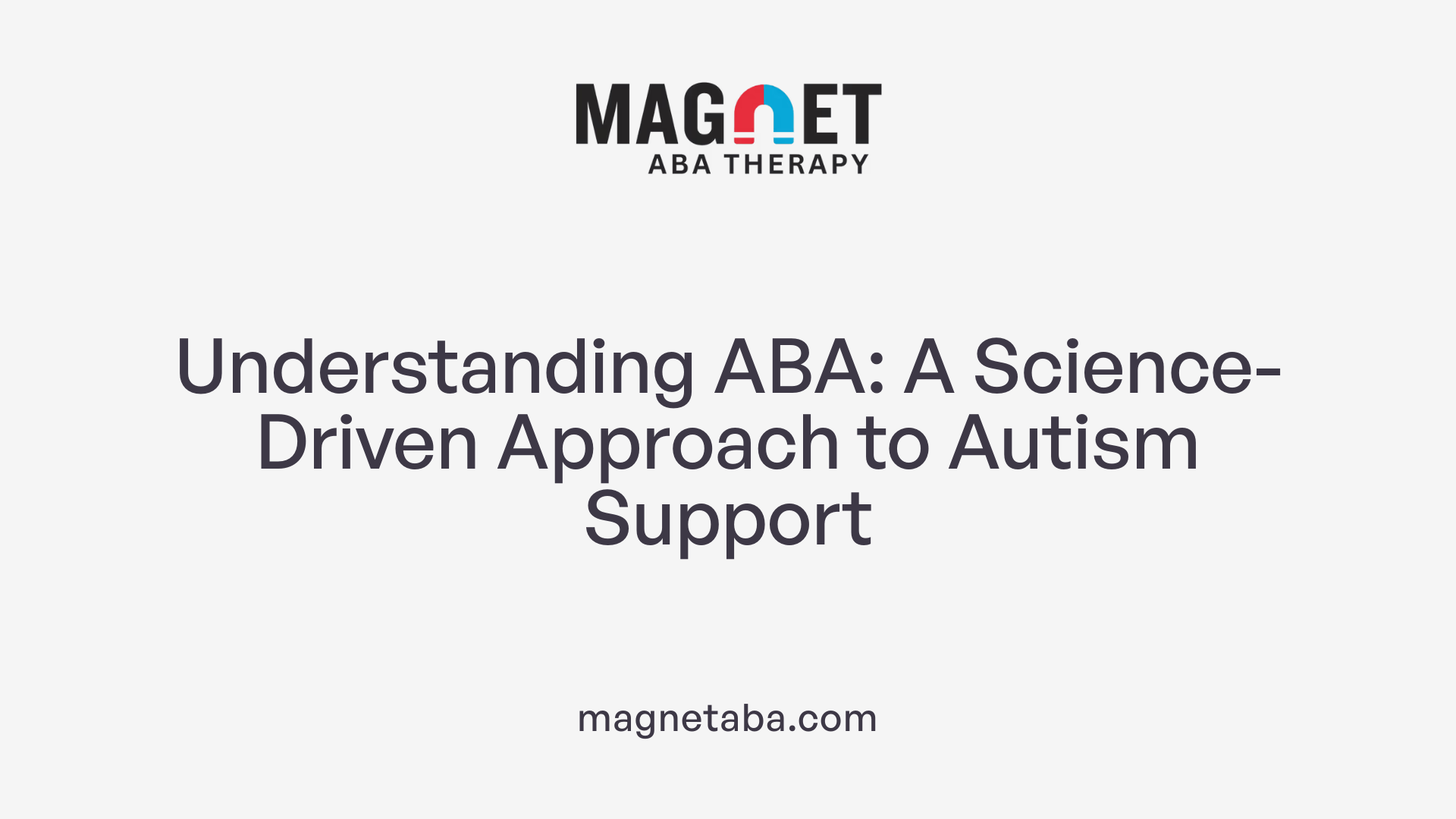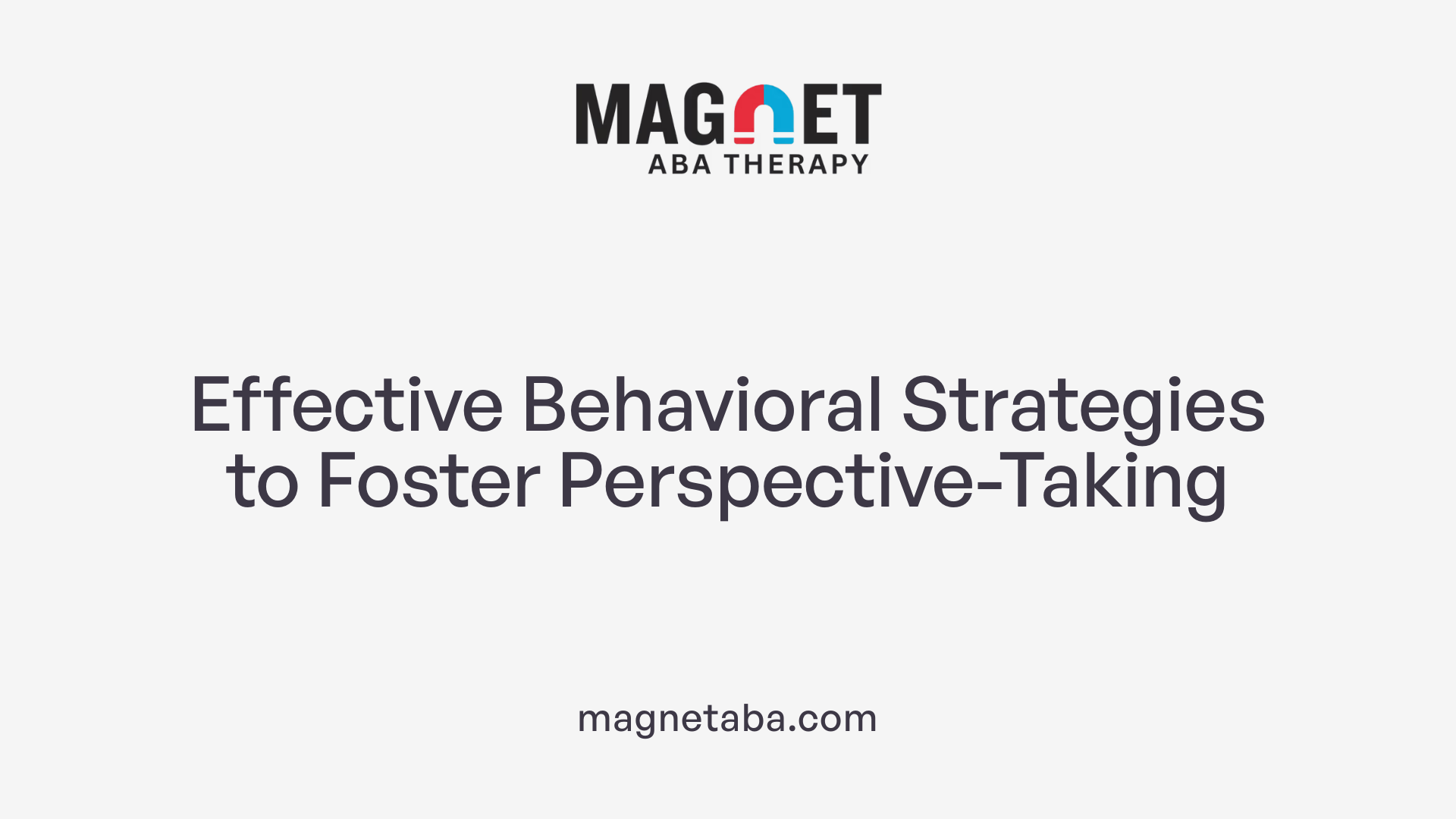Understanding the Foundation: Perspective-Taking and Autism
Perspective-taking—the ability to understand another person's thoughts, feelings, and viewpoints—is a cornerstone of effective social interaction. For individuals with autism spectrum disorder (ASD), mastery of this skill can be particularly challenging due to difficulties in grasping others’ mental states. Applied Behavior Analysis (ABA) therapy has emerged as a leading scientific approach to support the development of perspective-taking and related social-cognitive abilities in autistic individuals. This article explores strategies rooted in ABA and contemporary behavioral research that promote perspective-taking skills, emphasizing the importance of neurodiversity acceptance and practical application.
Defining Applied Behavior Analysis (ABA) and Its Role in Autism Therapy

What is Applied Behavior Analysis (ABA) therapy?
Applied Behavior Analysis (ABA) therapy is a scientific approach that applies learning and behavior principles to support individuals, especially those with autism spectrum disorder (ASD). It focuses on increasing useful social, communication, and daily living skills while reducing behaviors that might interfere with learning and social interaction.
ABA therapy uses methods like positive reinforcement, prompting, and systematic data collection to tailor interventions based on each person’s unique needs. This personal approach emphasizes building skills step-by-step and regularly assessing progress to ensure strategies are effective.
Application to Autism Spectrum Disorder
ABA is widely recognized for its success in helping people with ASD. By addressing challenges such as language development, social understanding, and self-care, ABA supports individuals in becoming more independent and confident. Interventions often include teaching perspective-taking and social cognition skills, which are areas of difficulty for many autistic individuals.
Typical Interventions and Goals
Common ABA strategies include direct instruction, role-play, video modeling, and real-life practice opportunities. Goals typically cover a broad range of skills, from communication and social interaction to academic readiness and motor coordination. The therapy aims not only to teach specific skills but also to improve overall quality of life.
Settings of ABA Delivery
ABA can be delivered in various environments, such as homes, schools, clinics, or community settings. Therapy hours vary depending on individual needs, sometimes encompassing intensive daily sessions. The flexibility of settings allows the therapy to be integrated into everyday routines, promoting generalization of skills.
Evidence Base and Professional Qualifications
Research consistently supports ABA as an evidence-based practice for autism intervention. Board-certified behavior analysts (BCBAs) and trained therapy teams lead these interventions, ensuring adherence to ethical standards and individualized care plans. Ongoing assessment and adjustments help maximize therapeutic outcomes.
In summary, ABA therapy is a personalized, evidence-driven approach designed to empower individuals with autism by enhancing their social, communication, and functional abilities through systematic, supportive interventions.
How ABA Therapy Benefits Individuals with Autism in Perspective-Taking Development
How does ABA therapy benefit individuals with autism?
ABA therapy benefits individuals with autism by teaching a broad range of skills tailored to each person's unique needs. It employs evidence-based methods such as positive reinforcement, prompting, and natural environment teaching to promote desirable behaviors and reduce challenging ones. This personalized approach targets communication, socialization, self-care, and academic skills.
Early intervention, ideally before age six, leads to significant developmental gains. Progress is carefully tracked with continuous data collection, allowing therapists to adjust treatment plans to optimize outcomes.
What skill areas does ABA target, including socialization and communication?
ABA therapy specifically targets socialization and communication skills essential for perspective-taking. It focuses on:
- Perspective-taking abilities: Teaching individuals to understand others' thoughts, emotions, and viewpoints.
- Social interaction skills: Enhancing the ability to engage in conversations, recognize social cues, and participate in group activities.
- Self-advocacy: Encouraging expression of personal needs and understanding others' perspectives.
How effective is early intervention?
Starting ABA therapy early, around age 4 or younger, aligns with the developmental window when Theory of Mind skills begin to emerge in neurotypical children. Early intervention maximizes the potential for acquiring foundational social-cognitive skills like perspective-taking, leading to better outcomes in communication and behavior.
How is treatment for perspective-taking monitored and customized?
Treatment progress is monitored through consistent data collection on performance and behavior. Therapists use this information to adapt interventions, such as incorporating role-play, video modeling, or social narratives, to meet the individual's evolving needs. Flexibility and patience are crucial, as skill acquisition in perspective-taking may be gradual.
What is the connection between behavior modulation and perspective-taking improvement?
ABA focuses on understanding and modifying specific behaviors by analyzing environmental factors and consequences. This behavioral approach helps individuals learn to interpret others' mental states and respond appropriately, thereby improving perspective-taking skills. Techniques like prompting and reinforcement promote these new social-cognitive abilities, which in turn enhance communication and social interactions.
| Aspect | ABA Therapy Application | Impact on Perspective-Taking |
|---|---|---|
| Skill areas targeted | Communication, socialization, self-care | Strengthens understanding of others' viewpoints |
| Early intervention timing | Before age six | Maximizes developmental gains in social cognition |
| Customization and monitoring | Data-driven treatment adjustments | Ensures individualized skill acquisition and generalization |
| Behavioral techniques | Positive reinforcement, prompting, role-play | Facilitates learning of social cues and mental states |
| Outcome | Increased independence, improved social skills | Better integration and quality of life for autistic individuals |
The Professionals Behind ABA Therapy: Training and Roles

Who provides ABA therapy and how are these professionals trained?
ABA therapy is typically delivered by professionals such as Board Certified Behavior Analysts (BCBAs) and Registered Behavior Technicians (RBTs). To become a BCBA, one must complete graduate-level coursework in behavior analysis, typically at the master's level, followed by 1,500 to 2,000 hours of supervised practical experience. After fulfilling these requirements, candidates must pass the Behavior Analyst Certification Board (BACB) exam.
RBTs undergo specialized training programs and certification through the BACB, preparing them to implement ABA interventions under the close supervision of BCBAs. This tiered system ensures that skilled professionals provide evidence-based services.
Supervision, Ethics, and Ongoing Education
Supervision plays a vital role in ABA therapy, with BCBAs overseeing RBTs and ensuring adherence to best practices and ethical guidelines. Ethical practice standards emphasize client dignity, respect, and individualized care.
To maintain licensure and certification, practitioners engage in ongoing education and professional development. Many states require formal licensure for behavior analysts, reinforcing commitment to continued learning and adherence to evolving standards.
Role in Individualized Treatment Planning
ABA professionals collaborate closely with clients and families to develop personalized treatment plans. Their comprehensive training enables them to assess behavior, apply data-driven interventions, and adjust strategies to meet unique needs, ensuring the effectiveness and responsiveness of services delivered.
Core ABA Methods Utilized to Teach Perspective-Taking Skills
What are the common methods used in ABA therapy?
Applied Behavior Analysis (ABA) therapy employs several effective methods to teach perspective-taking and other social skills. Among the most widely used are:
Discrete Trial Training (DTT): This method offers structured, step-by-step instruction with clear prompts and immediate reinforcement. It breaks skills down into small components and systematically teaches each step.
Natural Environment Teaching (NET): NET focuses on learning in everyday settings, encouraging children to apply perspective-taking in real life rather than just clinical settings.
Prompting and Prompt Fading: Prompting provides assistance or cues to help the learner respond correctly. Gradually fading prompts encourages independent skill use without overreliance.
Video Modeling and Social Narratives: Visual aids like videos demonstrate social interactions and perspective-taking scenarios, helping learners grasp abstract concepts. Social narratives describe situations to prepare learners for different social experiences.
Role-Play and Multiple Exemplar Training: Practicing social scenarios through role-play allows learners to explore different viewpoints actively. Multiple exemplar training ensures skills generalize across different contexts and people.
Reinforcement Strategies and Error Correction: Using positive reinforcement strengthens correct responses, while error correction helps learners understand and improve mistakes effectively. Systematic fade-out of prompts combined with reinforcement aids skill mastery.
Together, these ABA techniques offer a comprehensive toolkit for nurturing perspective-taking in children with autism. They enable targeted intervention tailored to individual needs, balancing structure with naturalistic learning opportunities to maximize social skill development.
Measuring Progress in ABA Therapy: Tracking Perspective-Taking Development

How is progress measured and assessed during ABA therapy?
Progress in ABA therapy is primarily tracked through systematic data collection methods involving direct observation and behavior charting. Initially, therapists perform baseline assessments to establish a starting point for each individual's perspective-taking abilities. These assessments help in understanding specific challenges and skill levels before intervention begins.
Ongoing monitoring is essential and involves regularly recording behaviors across sessions to capture changes over time. This consistent data collection ensures that shifts in skills such as understanding others' perspectives and emotions are documented clearly.
Graphs and other data visualizations play a critical role in analyzing therapy outcomes. By mapping behaviors over time, therapists can identify trends, assess the effectiveness of interventions, and decide if current techniques like video modeling or role-play are facilitating learning.
Collaboration between therapists and caregivers further strengthens the assessment process. Caregivers provide vital observations from natural environments, complementing clinical data. Together, they review progress reports and discuss necessary adjustments to the treatment plan, making ABA therapy highly personalized.
By relying on continuous, data-driven evaluation, ABA therapy ensures targeted development of perspective-taking skills. Adjustments based on this data support steady improvements and the attainment of individualized goals.
The Importance of Theory of Mind and Perspective-Taking in Social Cognition
What is Theory of Mind (ToM) and Why Does it Matter?
Theory of Mind (ToM) is the ability to understand that other people have their own unique thoughts, feelings, and viewpoints, different from one's own. This skill is fundamental for effective social cognition — it shapes how we interact, communicate, and build relationships with others.
How is Perspective-Taking Connected to ToM?
Perspective-taking is closely related to ToM and involves putting oneself in another person's shoes to appreciate their viewpoint. This ability allows people to infer others’ desires and beliefs, which is essential for successful social engagement and understanding social cues.
How Does Theory of Mind Show Up in Everyday Life?
Everyday examples of ToM include recognizing that friends might prefer different foods—like liking spicy dishes when you don't—and adjusting social plans accordingly. It also encompasses understanding emotions, laughing at jokes, and detecting when someone might be deceptive.
What Challenges Do Individuals with Autism Face in Developing ToM?
Typically, ToM begins developing around age four in children without developmental differences. However, individuals with autism spectrum disorder (ASD) often experience difficulties in acquiring these skills. These challenges impact their social communication, interaction, and imaginative play, making it harder to grasp others’ mental states.
How Does ToM Affect Social Interaction and Communication?
A developed Theory of Mind enables nuanced social interactions such as interpreting others’ feelings or predicting their reactions. Without this, social misunderstandings can occur, potentially leading to issues in forming friendships and navigating social settings. Understanding these elements highlights why perspective-taking is a key focus in supporting social cognition, particularly in autism interventions.
Behavioral Strategies to Enhance Perspective-Taking in Autism

Direct Teaching and Explicit Instruction Methods
One effective approach to enhancing perspective-taking in autistic individuals involves direct teaching and explicit instruction. Techniques such as multiple exemplar training help children recognize and interpret others' mental states by providing varied examples and reinforcing accurate responses. These methods clarify complex social concepts that may not be intuitive.
Role-Play and Social Narratives
Role-play exercises and social narratives offer practical applications for perspective-taking skills. Through guided scenarios and storytelling, individuals can practice stepping into others' shoes, understanding emotions, and predicting responses. Social narratives also help by framing social situations in relatable ways, supporting comprehension and empathy development.
Video Modeling and Naturalistic Teaching
Video modeling serves as a powerful visual tool, illustrating social interactions and perspective-taking behaviors in real contexts. Combined with naturalistic teaching opportunities—learning occurring in genuine social environments—this strategy encourages generalization of skills beyond structured settings, although further work is needed to improve transfer to everyday life.
Prompting, Reinforcement, and Error Correction
Behavioral interventions heavily rely on prompting strategies to initiate desired behaviors, followed by reinforcement to encourage their repetition. Systematic fade-out of prompts prevents dependency, while error correction procedures ensure accurate learning. Such methods shape perspective-taking skills effectively, supporting gradual mastery.
Training Components Like Gaze-Following and Match-to-Sample Procedures
Foundational skills like gaze-following are targeted because they underpin more complex perspective-taking abilities. For example, match-to-sample tasks teach children with autism to identify what others can see, an essential component of visual perspective-taking. These component trainings lay the groundwork for broader social understanding.
Overall, these behavioral strategies form a comprehensive toolkit to enhance perspective-taking in autistic individuals, fostering improved social cognition and interaction. Tailoring these interventions to individual needs, while maintaining patience and flexibility, is crucial for success.
Research Insights on Behavioral Interventions for Perspective-Taking
Review of experimental studies and methodologies
A recent review analyzed 29 experimental studies investigating behavioral interventions to enhance perspective-taking (PT) skills. The review followed stringent PRISMA-ScR guidelines to ensure comprehensive and systematic inclusion.
Theoretical approaches: Non-Derived vs. Derived Response
Two primary theoretical frameworks underpin the conceptualization of PT skills: Non-Derived Response and Derived Response approaches. Research trends indicate a shift toward the Derived Response approach, reflecting evolving understanding of PT's complexity.
Participant demographics and study designs
Most participants were boys under ten diagnosed with autism or related neurodivergent conditions. Single-Subject Designs predominated, allowing focused examination of individual intervention effects but limiting broader generalizability.
Ethical and methodological concerns
Many studies lacked thorough reporting on critical aspects, including participant demographics, interobserver agreement (IOA), procedural fidelity, social validity, and declarations of conflicts of interest. Such gaps underscore the need for improved research transparency and rigor.
Recommendations for future research
Future research should enhance methodological robustness by incorporating effect size calculations, ensuring comprehensive ethical assessments, and systematically evaluating social validity. This progress is essential to deepen understanding and improve intervention efficacy in PT skill development.
Balancing Therapy Goals with Neurodiversity Acceptance

Critique of Traditional Social Skills Training and Masking
Traditional social skills training often encourages autistic individuals to mask their autism by conforming to neurotypical social norms. However, this approach can lead to negative consequences such as exhaustion, increased anxiety, depression, and a decrease in self-esteem. Masking also risks erasing the unique social presentation styles of autistic people, contributing to misunderstandings and social fatigue.
Importance of Educating Neurotypical Peers
Research shows that first impressions of autistic individuals can be less favorable, not because of what they say but due to their social presentation styles. This highlights the importance of educating neurotypical peers and adults about these differences. Promoting acceptance and awareness of autistic social behaviors can reduce stigma and foster more inclusive social environments.
Focus on Awareness and Acceptance Rather Than Conformity
Therapeutic approaches now emphasize understanding and accepting neurodiverse social presentations instead of forcing autistic individuals to fit neurotypical molds. Interventions that prioritize awareness and respect for differences are seen as more ethical and supportive, reducing the pressures of masking and encouraging authentic self-expression.
Encouraging Self-Determination and Self-Advocacy
Goals for therapy include empowering autistic individuals to develop self-determination and self-advocacy skills. Teaching students to describe their perceptions, assess others’ motivations, and understand how communication choices are received helps build meaningful social problem-solving abilities rooted in perspective-taking.
Therapy Goals Aligned with Respect for Autistic Social Presentation
Effective therapy focuses on helping autistic individuals understand the reasons behind others’ behaviors and supporting their right to express themselves authentically. This approach contrasts with compliance-based methods and instead fosters respect for neurodiversity and personal identity. Overall, therapy aims to promote social understanding while honoring the individuality of autistic learners.
Practical Intervention Goals to Foster Perspective-Taking and Social Understanding
Describing Perceptions and Predicting Reactions
One foundational goal in interventions is helping autistic individuals articulate their own perceptions clearly. This skill supports self-awareness and sets the stage for predicting how others might react differently. By learning to describe their views, individuals can better anticipate social responses, which is critical for navigating varied social contexts effectively.
Assessing Motivations and Understanding Behaviors
Interventions also focus on helping individuals explore the reasons behind others’ actions. Understanding that behaviors are often motivated by different desires or beliefs is a vital aspect of Theory of Mind. This awareness encourages empathy and facilitates more thoughtful interactions by recognizing diverse social intentions.
Social Problem-Solving Through Perspective-Taking
Using perspective-taking as a tool for social problem-solving is another practical goal. Teaching individuals to consider multiple viewpoints promotes effective communication and conflict resolution. This approach can help manage misunderstandings and improve daily social interactions by framing problems through others’ perspectives.
Empowering Autistic Individuals Through Insight
Rather than enforcing conformity or masking of autistic behaviors, modern interventions champion empowering individuals with insight into social dynamics. This self-determination approach respects neurodiversity and supports self-advocacy, helping autistic individuals build confidence and navigate social environments on their own terms.
Real-World Application Beyond Masking
Importantly, therapy goals extend beyond encouraging impression management strategies. Instead, there is a strong emphasis on applying perspective-taking skills in real-life settings to enhance genuine social understanding. Such application reduces reliance on masking, thereby minimizing risks like exhaustion or anxiety often linked to traditional social skills training.
These targeted intervention goals collectively support autistic individuals in developing nuanced social cognition. Through explicit instruction, role-play, and naturalistic opportunities, therapies can promote meaningful perspective-taking that fosters acceptance and effective social functioning.
Challenges and Future Directions in Teaching Perspective-Taking
How well do learned perspective-taking skills generalize to natural settings?
While behavioral interventions have shown promise in teaching components of perspective-taking to children with autism, such as identifying what others can see, generalization to real-world environments remains a significant challenge. Studies reveal that skills practiced with picture stimuli often do not transfer effectively to everyday social interactions, highlighting the need for strategies that promote applicability beyond structured settings.
Why is patience and individualized intervention important?
Progress in developing perspective-taking skills can be gradual and varies substantially between individuals. Therefore, patience and tailoring interventions to each person's unique needs are essential. Flexible approaches incorporating direct teaching, video modeling, social narratives, and naturalistic opportunities allow for adjustments that respect the learner's pace and learning style.
What limitations currently affect research and practice?
Most existing studies predominantly involve young boys with autism using single-subject designs, limiting broader applicability. There is also a frequent lack of comprehensive reporting on participant demographics, procedural fidelity, interobserver agreement, and social validity. Ethical considerations, including avoiding harmful masking strategies, are sometimes insufficiently addressed.
How can future research improve rigor and ethics?
Enhancing methodological rigor by including effect size calculations, detailed participant data, and adherence to ethical standards like promoting neurodiversity acceptance is critical. Evaluating social validity ensures interventions are meaningful and respectful. These improvements will better guide effective and compassionate practice.
What is the potential of behavioral interventions in broader social skills development?
Behavioral approaches such as prompting, reinforcement, and modeling have demonstrated efficacy in building perspective-taking components. Although current gains are often narrow, these foundational skills can contribute to wider social, communicative, and imaginative abilities in autism when integrated thoughtfully. Emphasizing acceptance, self-advocacy, and understanding motivations aligns interventions with empowering autistic individuals rather than enforcing conformity.
Towards Effective and Respectful Perspective-Taking Interventions
Developing perspective-taking skills in individuals with autism is a nuanced process that requires scientifically supported behavioral strategies as well as a profound respect for neurodiversity. ABA therapy offers a framework of evidence-based methods—such as prompting, video modeling, and social narratives—tailored to each individual's unique profile. Simultaneously, modern therapeutic approaches emphasize empowering autistic individuals rather than enforcing conformity through masking, fostering environments where neurotypical peers also learn acceptance and understanding. Progress measurement through systematic data collection, combined with ongoing research improvements, continues to refine interventions. Ultimately, cultivating perspective-taking not only improves social interactions and communication but supports autistic individuals in self-determination and authentic social engagement, marking a hopeful future for therapy guided by compassion and science.
References
- Theory of Mind and Perspective Taking
- Behavioral interventions for teaching perspective-taking skills
- Why Perspective-Taking and Neurodiversity Acceptance? ...
- Teaching children with autism a basic component skill of ...
- How to Become an ABA Therapist - School of Education
- EIDBI - Treatment modalities - Certified providers
- Applied Behavior Analysis (ABA)
- Applied Behavior Analysis (ABA)











